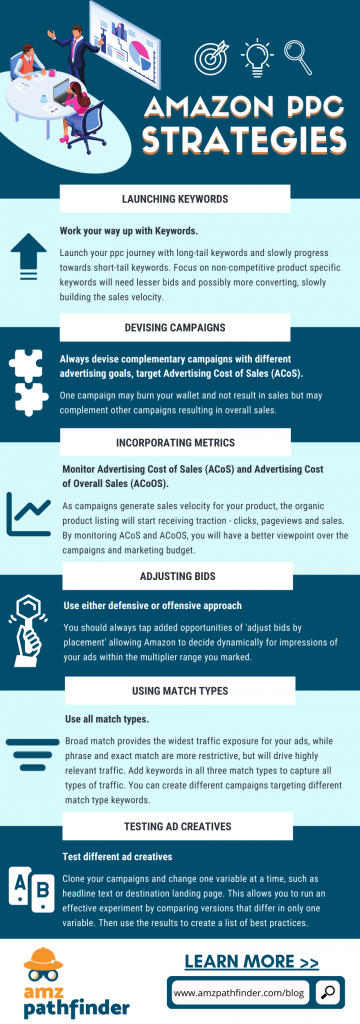Sellers often struggle with making Amazon Pay-Per-Click (PPC) efforts for their stores. Some of them don’t even see the need to conduct such campaigns. Unknown to them, Amazon PPC holds one of the keys to succeeding on Amazon. By advertising their products, sellers can target specific keywords that they can use to promote their products. Doing this will allow their listings to appear on Amazon’s search results pages and eventually help them have close competition directly on their competitors’ product pages.
While creating ads can be a walk in the park for many seasoned sellers, having your own strategies helps your products get noticed, and it can also help maximize your sales potential. To help you develop effective advertising techniques, here are some of the best strategies you can use for your Amazon Ads campaigns:
Launching Keywords in Amazon PPC

It’s every Amazon seller’s dream to nail the right keywords that their target market is specifically searching for. And who wouldn’t want that? Using the right keywords can ultimately land your ads in a great spot. While many would use short-tail keywords that their keyword tools recommend, it’s a great idea to go with long-tail keywords before heading in that direction.
Subscribe to our newsletter
When choosing a long-tail keyword, remember to focus on non-competitive product-specific keywords that will require lesser bids. They will eventually help you convert more customers and slowly build the sales velocity it needs to succeed.
There are several ways you can maximize launching keywords into your ads:
-
Add your most important keywords in your header
Amazon is different from Google. You don’t need to repeat your keyword multiple times throughout the listings to improve your ranking. You only need to include it once and add your other important keywords to your product descriptions. More keywords don’t guarantee higher rankings and impressions.
-
Monitor your keyword performance
If there’s anything more important than finding keywords, it’s making sure they can drive traffic. It’s a common mistake for many Amazon sellers to simply find keywords that have current high demand at the time of research. Sellers must avoid adding keywords without updating them from time to time. Buyers can often change their minds and may use different keywords, so your listings must be on track with those changes.
-
Don’t be too subjective
It’s easy to get lost in optimizing your ad’s title for the sake of making it stand out. When you become subjective with keywords and add words like “cheapest,” “tastiest,” or any other opinion-driven keywords, you may think that people will notice your ad and instantly believe it. While that may be true in some cases, it’s not always the case for organic searches. Buyers will usually search for the name of the product they’re looking for rather than adding an adjective before the keyword.
Devising Amazon PPC Campaigns
Who would’ve thought that the proverb, “Don’t put all your eggs in one basket,” would apply to your Amazon Ads campaigns as well? Relying on an advertising campaign that has worked for you might be a safe choice, but with the ever-changing trends and demands of buyers, the way you advertise on Amazon needs to be able to adapt to those changes, too. Make your campaign bids even safer by devising complementary campaigns that meet different advertising goals.
For good measure, it’s best to target your Advertising Cost of Sales (ACoS) as this can help you budget your Ad Spend without having to sacrifice your income per sale. Think of the other campaigns as team members in a group who can support each other when one of them fails to perform a task they’re intended to. What’s even better is that these team members can help you even while you sleep!
Incorporating Metrics
Besides keywords, it’s also vital to incorporate the use of metrics in your Amazon Ads campaigns. Among Amazon’s wide variety of metrics, it’s recommended that you optimize your Advertising Cost of Sales (ACoS) and Advertising Cost of Overall Sales (ACoOS). These metrics can give you a better overview of what is and isn’t working for your campaigns and marketing budget.
-
Monitoring Advertising Cost of Sales (ACoS)
This key metric gives you an idea about your Amazon PPC campaign’s performance. It calculates how much of every dollar you earned through advertising was spent on each ad campaign. When targeting good ACoS, you need to keep in mind that this metric varies for different categories. It may also depend on the prices, marketplace, the competition your products are getting, and the ad type you’re advertising with.
Some sellers might be worried about having high ACoS. However, having a high ACoS isn’t always worrying as it will also depend on the time of year, product portfolio, and category. You get your ACoS by dividing your Ad Spend by your Ad revenue and multiplying the quotient by 100 (ACoS = Ad Spend / Ad Revenue x 100).
Breakeven ACoS is the highest ACoS we can achieve before you no longer make any profit. To calculate this, use the following formula:
Definition on Post Launch Testing:
Sale Price – Amazon Fees – Cost of Goods = Pre-ad Profit Per Sale
Pre-ad Profit / Sale Price = Breakeven ACoS
-
Monitoring Advertising Cost of Overall Sales (ACoOS)
Similar to Blended ACoS, the ACoOS is the advertising cost compared to all paid and organic sales. It’s referred to as ‘blended’ due to its formula of blending the total revenue with the ad spend. Several big brands on Amazon often monitor their ACoOS just as much as they do their ACoS.
ACoOS contributes to organic sales, making it vital for tracking your profit margin. By monitoring your ACoOS, you can effectively measure the impact of your advertising on your Amazon store. This helps you understand the correlation between your increasing organic sales and your advertising efforts.
Adjusting Bids in Amazon PPC Campaigns
When it comes to bidding on Amazon, make sure to always tap on the added opportunities of ‘adjust bids by placement,’ which can allow you to choose campaigns that will decide the placement of your ads. This feature also allows you to have more control over your budget for ad placements and increase your bids at the campaign level from 0% to 900%.
Adjusting bids will control the percentage within your campaign’s targeting group or selection of keywords. Sellers and vendors can take advantage of this feature via the automatic and manual Sponsored Products campaigns at the top of the search, product pages, and rest of the search.
There are three Amazon PPC bidding strategies you can try when adjusting your bids:
-
Fixed Bids
For fixed bids, Amazon won’t dynamically adjust your ad spend for the chance of higher conversion. Instead, Amazon will use the exact bid sellers allot for each keyword in every ad opportunity. While this strategy is effective, it’s not highly recommended as there are potential cost reductions and efficiency gains. Instead, only use this for new campaigns as it can help you gather new data.
-
Dynamic bids, up and down
For dynamic bids that go up and down, Amazon has the liberty to either increase or decrease your ad opportunity bids based on the likeliness of a conversion. Amazon may increase your bid up to 100% for ad placements located at the top of the first page of the Amazon search results. Amazon will not increase bids by more than 50% for Sponsored Products in top search placements. Also, Amazon will not increase your bid by more than 50% for Product Pages and other ad placements.
-
Dynamic bids, down only
For dynamic bids that are down only, Amazon will adjust your bids down for ad opportunities that are less likely to convert. Amazon will be able to reduce your bid up to 100% if needed, especially if the probability of conversion becomes too low. Among all the other bid types, this is usually the most recommended.
It states your bid as the maximum cost-per-click based on the efficiency target set of your ad group or ad campaign.
Using Match Types
For optimized search and good measure, it’s best to use all match types such as the broad, phrase, and exact matches. Match types allow you to gain control over which customer search queries will match the keywords you’ve input for manual targeting on your Amazon ad campaigns. It’s almost impossible to track every single keyword Amazon visitors type in the search bar to look for specific products. The keyword match types are there to help you target them efficiently, helping you avoid wasted ad spend and allowing you to meet your ad goals.
When you create campaigns that target specific match-type keywords, you’ll be able to find new customers by targeting them and lessen the chances of your competitors gaining their attention. Given that there are three different match types, each of them has different rules and definitions:
-
Broad Match
This match type allows for the inclusion of all the keyword terms, including the close variations of the keyword. It doesn’t follow any order and may contain additional words. Everything also needs to be in the same order.
Sample broad match keyword: talking cactus toy
Eligible keywords: talking cactus toy for toddlers, talking cactus
Ineligible keywords: talking cactuses, dancing cactus
-
Exact Match
In its name, the exact match type is very specific for the keyword, phrase, and close keyword variations for search queries. Unlike the broad match type, the exact match type will not allow additional words and different orders.
Sample exact match keyword: fleece blanket
Eligible keywords: fleece blanket, fleece blankets
Ineligible keywords: blankets made of fleece, soft fleece blanket, fleece blanket (misspelling)
-
Phrase Match
With the phrase match type, close variations and the exact phrases must be included and must be in the same order as the keyword used.
Sample phrase match keyword: baking pan
Eligible keywords: aluminum baking pan, best baking pans
Ineligible keywords: pans for baking, banana bread pans
Testing Ad Creatives for Amazon PPC
It’s not a secret that many Amazon buyers are pretty visual and judge the brand’s quality and integrity through its creatives. Play around with ad creatives to get a good idea of what types of headlines, texts, destination pages, images, colors, and other creative assets will make your campaigns pop.
It’s best to clone campaigns and change different variables at a time. Set exact, specific times for each experiment to help you figure out which creatives are most effective for your niche. Once you’ve finished experimenting, put them all together in one document to create your own personalized best practices guide.
To help you get started on experimenting with elements, here is a list of the five basic elements of effective creatives for your ads:
-
Images
Use high-resolution images or photos to allow buyers to see where your product fits in their lives and how much great value it will bring after having purchased it. Brand images should be concise, and they must communicate value to buyers’ personal lives. They need to radiate positivity and a sense of resolving a buyer’s specific pain points.
The photos should also focus on the product itself and not have any distractions. There can be one or two things surrounding your product, but it must be something that emphasizes its use. It’s also good to promote diversity by choosing models of various races, ethnicities, ages, and weights.
-
Brand Logo
To keep your branding consistent with your images, make sure to add clear versions of your logo to your ad creatives. Not only will your product not be mistaken with another brand, but it can also establish credibility and a strong connection with your customers.
According to Amazon’s guide on creating logos, your brand logo must fill all available spaces when uploaded. It should use text that’s big enough to be easily read. A logo needs to be positioned on top of white background to make all its elements visible. Also, it must reflect the brand or product accurately.
-
Headline
A brand isn’t complete without a message in the form of a headline. It must be plain and simple to understand. The headline must communicate brand goals to the largest possible audience, and it is usually the only thing they see.
Be sure to state your brand goals and how your customers can benefit. Make a great impact with your headlines by creating them in the style of asking questions, injecting humor, conveying empathy, and highlighting a problem your product solves.
-
Call to Action (CTA)
When customers visit your product listings or your Amazon store, several things are on their minds. They’ll be distracted by everything you have to offer, especially if they’re not looking for a specific product yet. Since only your ads, images, and listings can speak for you, why not turn your creatives into an exciting map that your customers can follow while they’re there?
Some of the ways you can do this are by adding call to action links on your creatives that say “Learn more” or “Buy Now!”. This way, when they click on CTA that’s on your creative, your objective is clear, and you can quickly sign them on a sales funnel that can convert more customers.
-
Body copy
Images can be attractive and a quick way for catching attention, but your body copy is what provides leverage for customers to become interested in your brand or product. You don’t have to put too much flair on your body copy, as many would imagine. You need to use precise and straightforward language that highlights what your product or brand can do and how it can help them.
Similar to CTAs, it can be in the form of a question, a supportive statement to your headlines, and anything else that can help meld your ideas together and make them as attractive and effective as you possibly can.
Conclusion
Creating strategies for your Amazon PPC campaigns is a big challenge many successful Amazon sellers have overcome. There’s a wide variety of tools for tracking metrics and helping you spread the word about your brand. So, there are no more excuses to be less popular and have low conversion rates on Amazon. You only need to learn how to experiment with ad budgets, bidding, and marketing your creatives, and you’ll be unstoppable!
Looking for more tips and tricks in the world of Amazon selling? Check out AMZ Pathfinder’s wide variety of blogs today!
About the author

Soraya Danica Dimayuga is a Content Writer at AMZ Pathfinder who helps Amazon Sellers stay updated with the latest Amazon news. She has been in the international Digital Marketing sphere for over seven years. Soraya is currently sharing her SEO and Content Writing expertise with her current role. You can read more of their team’s Amazon PPC blogs on the AMZ Pathfinder blog.


